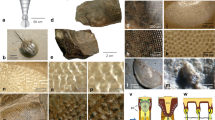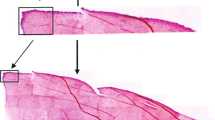Summary
-
1.
Phronima, and many other oceanic hyperiid amphipods, have double eyes in which the medial (dorsal) part has a small field of view and large facets, and the lateral (ventral) part a large field and small facets (Fig. 6).
-
2.
The eyes are of the apposition type. Each crystalline cone forms an image at its proximal tip (Fig. 3), which in most hyperiids abuts directly onto the rhabdom. The exception is the medial eye ofPhronima where light from the image is conveyed via a narrow light-guide to the retina 5 mm ventral to the eye surface (Fig. 2). Living eyes all show pseudopupils (Fig. 4).
-
3.
It is shown by interference microscopy that the crystalline cones inPhronima eyes are inhomogeneous (Figs. 7–8, 11–13). Medial eye cones have a V-shaped refractive index gradient, densest at the distal tip (1.40). Lateral cones are dense at both distal (1.38) and proximal (1.45) ends, with a less dense zone in between. Ray tracing (Figs. 9 and 13) confirms that images are formed at the proximal ends of both types of cone.
-
4.
Measurements made on the pseudopupil and from ray tracing confirm that in the medial eyes the acceptance angles of single light-guides are larger than the inter-ommatidial angles by a factor of 8 (Δp=3.5 °, Δφ=0.44 °). This means that as many as 60 rhabdoms in each medial eye view the same point in space. There is no such discrepancy in the lateral eyes, where Δp≃15 ° and Δφ is 9–12 °. The entire field of view of each medial eye (approximately 10.5 by 11 °) is about the same as that of a single ommatidium in the lateral eye.
-
5.
It is argued in the Discussion that, whilst a high Δp: Δφ ratio would be a disadvantage if a textured background had to be resolved, it is a good solution to the problem of locating single small objects in dim light,provided that all the rhabdoms that view the same point in space pool their signals. A substrate for such pooling appears to exist in a plexus overlying the lamina of the medial eye, which is not present in the lateral eye lamina (Fig. 16).
-
6.
The structure of the eyes of the deep-livingCystisoma, which has no lateral eyes, differs fromPhronima in that the retina is curtain-like, with widely separated, unscreened rhabdoms, instead of being a small dark condensed structure. It is suggested that these represent alternative ways of making eyes that are minimally visible to potential predators (Fig. 17).
Similar content being viewed by others
References
Ball EE (1977) Fine structure of the compound eyes of the midwater amphipodPhronima in relation to behavior and habitat. Tissue Cell 9:521–536
Barlow RB, Chamberlain SC, Levinson JZ (1980)Limulus brain modulates the structure and function of the lateral eyes. Science 210:1037–1039
Bowman TE, Gruner HE (1973) The families and genera of Hyperiidea (Crustacea: Amphipoda). Smithson Contrib Zool, vol 146. Smithsonian Institute Press, Washington, DC
Bruno MS, Barnes SN, Goldsmith TS (1977) The visual pigment and visual cycle of the lobsterHomarus J Comp Physiol 120:123–142
Claus C (1879) Der Organismus der Phronimiden. Arb Zool Inst Univ Wien 2:1–88
Exner S (1891) Die Physiologie der facettierten Augen von Krebsen und Insecten. Deuticke, Leipzig Wien
Franceschini N, Kirschfeld K (1971) Les phénomènes de pseudopupille dans l'oeil composé deDrosophila. Kybernetik 9:159–182
George D, George J (1979) Marine life. Wiley, New York
Hausen K (1973) Die Brechungsindices im Kristallkegel der MehlmotteEphestia kühniella. J Comp Physiol 82:365–378
Horridge GA (1976) The ommatidium of the dorsal eye ofCloeon as a specialization for photoreisomerization. Proc R Soc Lond [Biol] 193:17–29
Horridge GA (1978) The separation of visual axes in apposition compound eyes. Philos Trans R Soc Lond [Biol] 285:1–59
Horridge GA, Duelli P (1979) Anatomy of the regional differences in the eye of the mantisCuilfina. J Exp Biol 80:165–190
Horridge GA, McLean M (1978) The dorsal eye of the mayflyAtalophlebia. Proc R Soc Lond [Biol] 200:137–150
Kirschfeld K (1979) The visual system of the fly: physiological optics and functional anatomy as related to behavior. In: Schmitt FO, Worden FG (eds) The neurosciences 4th study program. M.I.T. Press, Cambridge, MA, pp 297–310
Koizumi K, Ikeda Y, Kitano I, Furukawa M, Sumimoto T (1974) New light-focusing fibres made by a continuous process. Appl Opt 13:255–260
Kunze P (1979) Apposition and superposition eyes. In: Autrum H (ed) Handbook of sensory physiology, vol VII/6A. Springer, Berlin Heidelberg New York, pp 441–502
Land MF (1979) The optical mechanism of the eye ofLimulus. Nature 280:396–397
Land MF (1980a) Compound eyes: old and new optical mechanisms. Nature 287:681–686
Land MF (1980b) Optics and vision in invertebrates. In: Autrum H (ed) Handbook of sensory physiology, vol VII/B. Springer, Berlin Heidelberg New York, pp 471–592
Land MF, Burton FA, Meyer-Rochow VB (1979) The optical geometry of euphausiid eyes. J Comp Physiol 130:49–62
Lockett NA (1977) Adaptations to the deep-sea environment. In: Crescitelli F (ed) Handbook of sensory physiology, vol VII/5. Springer, Berlin Heidelberg New York, pp 67–192
Lythgoe JN (1979) Ecology of vision. Clarendon Press, Oxford
Marshall NB (1954) Aspects of deep-sea biology. Hutchinson, London
Meggitt S, Meyer-Rochow VB (1975) Two calculations on optically non-homogeneous lenses. In: Horridge GA (ed) The compound eye and vision of insects. Clarendon Press, Oxford, pp 314–320
Rossel S (1979) Regional differences in photoreceptor performance in the eye of the praying mantis. J Comp Physiol 131:95–112
Sherk TE (1978) Development of the compound eyes of dragonflies (Odonata) III. Adult compound eyes. J Exp Zool 203:61–79
Snyder AW (1979) The physics of compound eyes. In: Autrum H (ed) Handbook of sensory physiology, vol VII/6A. Springer, Berlin Heidelberg New York, pp 225–313
Stavenga DG (1979) Pseudopupils of compound eyes. In: Autrum H (ed) Handbook of sensory physiology, vol VII/6A. Springer, Berlin Heidelberg New York, pp 357–439
Thurston MH (1976) The vertical distribution and diurnal migration of the Crustacea Amphipoda collected during the SOND cruise, 1965. J Mar Biol Ass UK 56:383–470
Author information
Authors and Affiliations
Additional information
My thanks are due to Peter Herring of the Institute of Oceanographic Sciences, Wormley, U.K. who organized the Discovery cruises, and the Michael Thurston, also of the I.O.S. for taxonomic and general advice on amphipods. Jonathan Ashmore, Ian Russell and Jochen Zeil all made helpful criticisms of the manuscript, which was typed by Sally Byatt. The research was funded by the N.E.R.C. (at sea) and the S.R.C. (at Sussex).
Rights and permissions
About this article
Cite this article
Land, M.F. Optics of the eyes ofPhronima and other deep-sea amphipods. J. Comp. Physiol. 145, 209–226 (1981). https://doi.org/10.1007/BF00605034
Accepted:
Issue Date:
DOI: https://doi.org/10.1007/BF00605034




